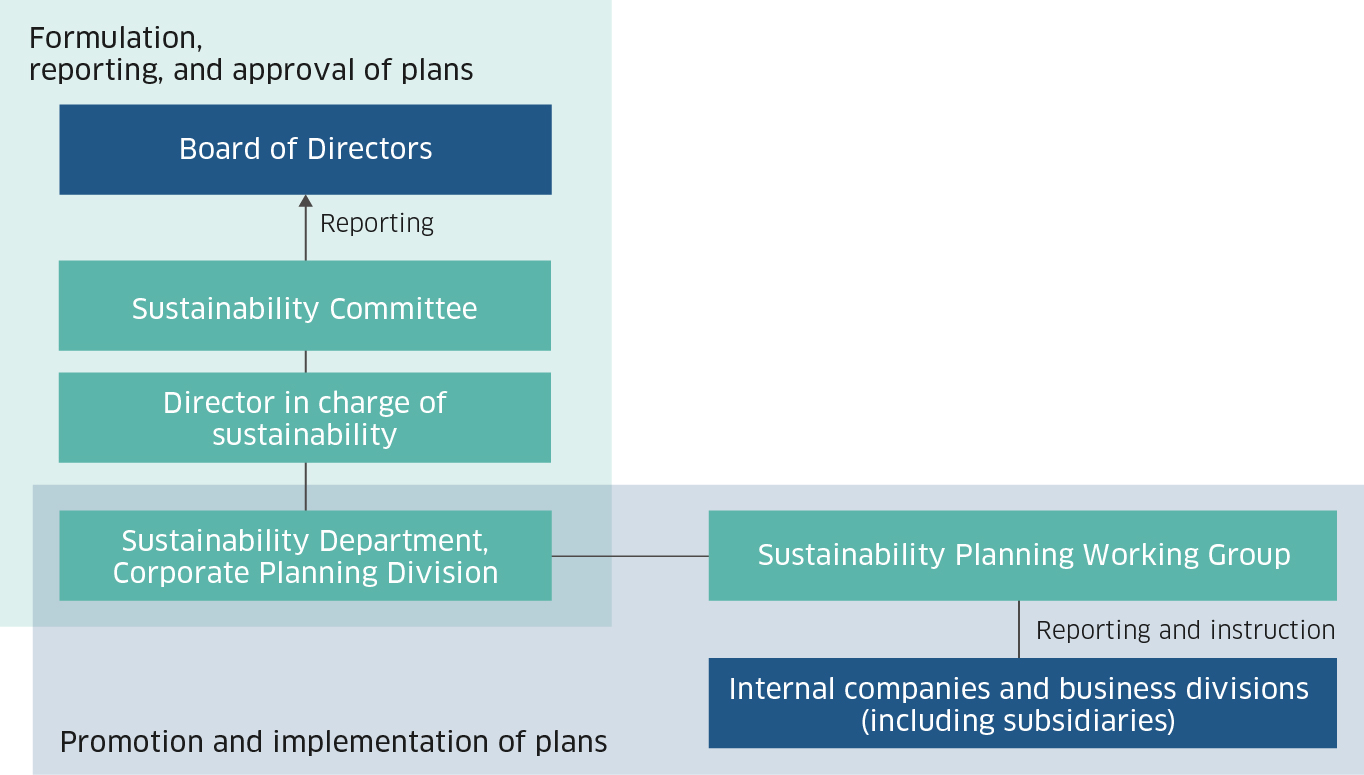Information Disclosure in Line with the TCFD Recommendations (Scenario Analysis)
- Disclosure in Line with the Recommendations of the Task Force on Climate-related Financial Disclosures
- Governance (Organizational governance of climate-related risks and rewards)
- Strategy (Actual and potential impact of climate-related risks and opportunities on business, strategy and financial planning)
- Risk Management (Methods for identifying, assessing and managing climate-related risks)
- Indicators and Targets (Indicators and targets employed when assessing and managing climate-related risks and opportunities)
- Climate Change Scenario Analysis
Disclosure in Line with the Recommendations of the Task Force on Climate-related Financial Disclosures
Under its Group Vision 2030, the Kawasaki Group will actively contribute to the realization of a society in which the average global temperature rise is held to 1.5℃ above pre-industrial levels—the goal of the Paris Agreement—through its business, by advancing its hydrogen business, CCUS*1 and other efforts. At the same time, the Group is moving forward with measures, based on risk analysis, to address increasingly severe natural disasters, including business continuity planning (BCP), supply chain resilience and others. Here we report on climate change-related information based on TCFD recommendations.
- *1 Carbon dioxide Capture, Utilization and Storage
Governance (Organizational governance of climate-related risks and rewards)
Kawasaki has established a Sustainability Committee, chaired by the President, to provide a system for discussion and reporting regarding its environmental management strategy, including climate change risks and opportunities; committee meetings are held at least twice a year. The Sustainability Committee regularly reports on its activities to the Board of Directors, which makes policy decisions regarding climate change-related initiatives and discusses other important matters.

Strategy (Actual and potential impact of climate-related risks and opportunities on business, strategy and financial planning)
In energy and environmental solutions, one of three focal fields defined in the Group Vision 2030, the Group is actively advancing business aimed at realizing a decarbonized society through the hydrogen business, CCUS and other efforts.
In the current scenario analysis, we looked at the Group in its entirety to perform a comprehensive assessment in terms of (i) an assessment by industry; (ii) CO2 emissions; (iii) business size and future growth potential; and (iv) climate change-related opportunities and risks. We then identified those businesses that will be significantly impacted by climate change. We conducted a quantitative assessment (financial impact assessment) of the Energy Solution and Marine Engineering segment, which faces the greatest impact, as well as a qualitative assessment of the Aerospace Systems and Motorcycle & Engine segments, which will see the next-largest impact. Considering consistency with the Group Vision 2030, the year 2030 was set as the target year, with the analysis based on a scenario of 1.5℃ and 4℃.
Risk Management (Methods for identifying, assessing and managing climate-related risks)
The identification and assessment of risks related to climate change are conducted by the Sustainability Committee. Risks are identified in accordance with TCFD categories, including transition risks, physical risks and others, and are assessed based on the size of their impact. The most significant risks among these are reported to the Board of Directors, which then holds discussions regarding countermeasures.
Indicators and Targets (Indicators and targets employed when assessing and managing climate-related risks and opportunities)
The Group has established CO2 emissions reduction targets, as shown in the chart below.
For domestic Scope 1 and 2, including Group companies, our goal is to achieve self-sustaining carbon neutrality by 2030 through initiatives centered primarily around hydrogen power generation. For Scope 3, targets have been established for main categories (i) and (xi).
Our goal is for zero CO2 emissions across the Group as a whole by 2050, in line with the CO2-free target set out in the Kawasaki Global Environmental Vision 2050.
Kawasaki Group CO2 Emissions Reduction Targets
| Scope 1, 2 | Scope 3 |
|---|---|
| 2030 Net Zero Scope: Domestic Group companies |
2040 Zero-Carbon Ready
|
| 2050 Net Zero Scope: Entire Group (consolidated) |
|
Climate Change Scenario Analysis
1.5℃ Scenario (As of 2030) If Group Vision 2030 Is Achieved
| Business Segment | Energy Solution & Marine Engineering Segment | Aerospace Systems Segment | Motorcycle & Engine Segment | |
|---|---|---|---|---|
| Assumptions |
|
|||
|
|
|
||
| Opportunities | Hydrogen-related |
|
|
|
| CCUS |
|
— | — | |
| Electrification |
|
|
|
|
| Alternative Fuels |
|
|
|
|
| Other |
|
|
— | |
| Risks |
|
|
|
|
| Financial Impact (2030 net sales) |
|
|
|
|
| Kawasaki's measures to address opportunities and risks | Hydrogen-related |
|
|
|
| CCUS |
|
— | — | |
| Electrification |
|
|
|
|
| Alternative Fuels |
|
|
|
|
| Other |
|
|
|
|
4℃ Scenario (as of 2030) in the Absence of Progress with Group Vision 2030
| Business Segment | Energy Solution & Marine Engineering Segment | Aerospace Systems Segment | Motorcycle & Engine Segment |
|---|---|---|---|
| Assumptions |
|
||
| Opportunities |
|
|
— |
| Risks |
|
||
|
— |
|
|
| Financial Impact |
|
(Scheduled for future implementation) | (Scheduled for future implementation) |
| Kawasaki's measures to address opportunities and risks |
|
|
|
|
|||
Note: EV: Electric Vehicle; HEV: Hybrid Electric Vehicle; GHG: Greenhouse Gas
Contact
If you need more information about our business,
please feel free to contact us.





